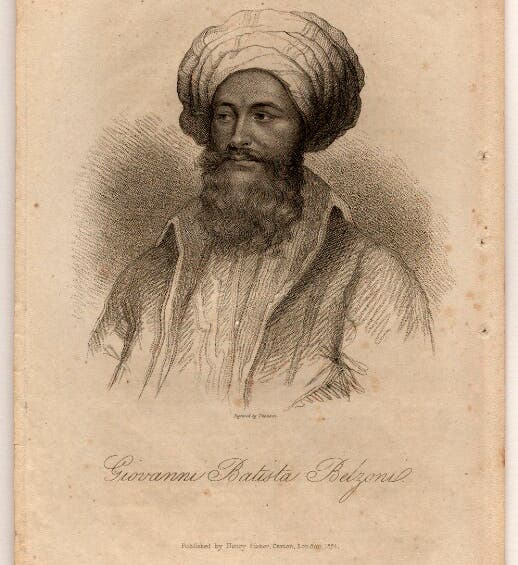Scientist of the Day - Giovanni Battista Belzoni
Giovanni Battista Belzoni, an Italian adventurer, was born Nov. 5, 1778. Aptly described as "larger than life," Belzoni stood 6 feet 7 inches tall. After he fled his native Padua for England during the Napoleonic invasions of Italy, Belzoni made his living for some years as a strongman at fairs and circuses in London. One of his acts was to carry on his shoulders a metal frame with a dozen attached seats, which a dozen men and maidens would mount while Belzoni strutted about the stage. We even have a contemporary watercolor of this very feat of strength.
After some years of performing, and having acquired a bride, Belzoni decided in 1815 to seek his fortunes in Constantinople. On the way, during a stopover at Malta, Belzoni was persuaded to set sail instead for Cairo, where it was thought he could be of use to the Pasha. That thought was wrong, but in Cairo, Belzoni met Henry Salt, who had just been appointed British consul to Egypt. Salt wanted to acquire antiquities for the British Museum, and the antiquities he had in mind would require both brains and brawn. Belzoni was perfect for the job, from Salt's point of view, and historical events would prove him correct.
Belzoni's first task was to go up the Nile to Thebes, to the area we now call the Ramesseum, and bring back a large syenite head that was lying on the ground. It was known as the "Younger Memnon," to distinguish it from a larger fallen statute that they could have called "Old Memnon" but instead referred to as “Ozymandias”. Salt knew exactly where the head was – it had actually been discovered by Napoleon's savants in 1799 and illustrated in the Antiquities volumes of the Description de l'Egypte – and he knew how to negotiate the rights to its acquisition, but he couldn’t find anyone to move it. Belzoni went there in the summer of 1816, and using naught but palm-leaf ropes, rollers, poles, and an army of Egyptian labor, he hauled the head to the shores of the Nile and then downriver to Alexandria. Here is a not-quite-contemporary depiction of Young Memnon's roller-coasting ride (second image). Salt eventually sold Memnon’s head to the British Museum, where it went on display in 1821, and where it remains on view to this day, now properly identified as a bust of Ramesses II (third image). Percy Bysshe Shelley was supposedly inspired by the news of its acquisition to compose one of his most remembered poems, Ozymandias, but in fact, the poem was published in 1818, long before the head showed up on British shores. If Shelley was inspired by anything, it was by a plate in the Description de l'Egypte, showing “two vast and trunkless legs of stone” at Karnak and published in 1812.
Belzoni went on to unearth Abu Simbel from its shroud of sand and become the first to enter that temple. He was the first to find the passage into the second pyramid at Giza and enter the burial chamber (well, not quite the first, since the burial chamber was empty when he got there, but the first European to do so). He discovered the tomb of Ramesses III in the Valley of the Kings and removed the sarcophagus (which was also empty) for Salt, who sold it to the Louvre, where you can see it today. He also found the tomb of Seti I and removed that sarcophagus as well, one of the most beautiful sarcophagi the Egyptians ever constructed, since it was cut from solid alabaster. The British Museum balked at Salt's high asking price, so this one ended up in the Sir John Soane Museum in London, where it is often described as the finest piece of Egyptiana in England, even though the white alabaster has darkened and the hieroglyphics that originally decorated its surface (see this wood engraving of 1864) have faded from view in the English air.
It is easy to be harsh on Belzoni and see him as a common antiquities thief and grave robber, but one should bear in mind that in 1820, attitudes toward antiquities were quite different from what they are at present, and it is hard to blame Belzoni for doing what everyone in France and England seemed to think was proper and above-board. Belzoni certainly did not profit much from his efforts, not compared to Henry Salt, anyway. And he merits some additional sympathy because of his early death; he decided in 1823 to try to locate the fabled city of Timbuktu in West Africa and perished on the way, of dysentery. His long-suffering wife Sarah not only inherited nothing, but survived her husband by some 47 years, which gives long-suffering a new meaning.
Belzoni published A Narrative of the Operations and Recent Discoveries within the Pyramids, Temples, Tombs, and Excavations, in Egypt and Nubia (1820) and an accompanying Atlas des voyages, recherches et découvertes de G. Belzoni en Egypte en Nubie (1821). Both works are in the Spencer Art Reference Library of the Nelson-Atkins Museum of Art, not a mile from us; both were the gift of Jeffrey Weidman, who has given us many rare volumes as well, which we much appreciate.
There are a number of portraits of Belzoni but few really good ones; we like the stipple engraving of 1822 in the National Portrait Gallery in London (first image).
Dr. William B. Ashworth, Jr., Consultant for the History of Science, Linda Hall Library and Associate Professor emeritus, Department of History, University of Missouri-Kansas City. Comments or corrections are welcome; please direct to ashworthw@umkc.edu.








